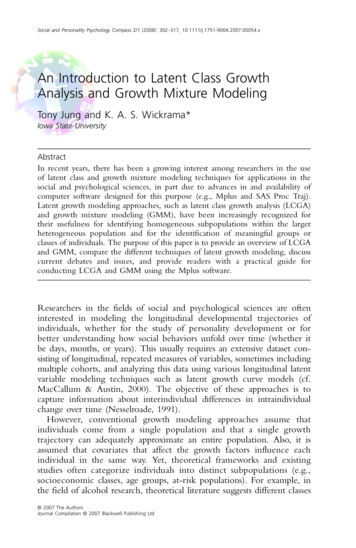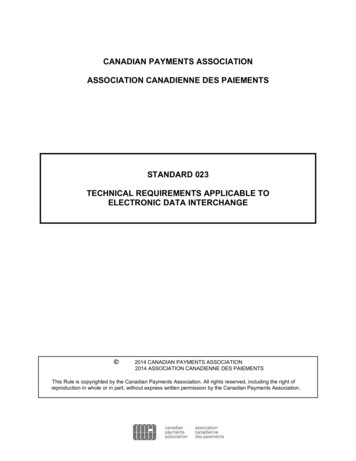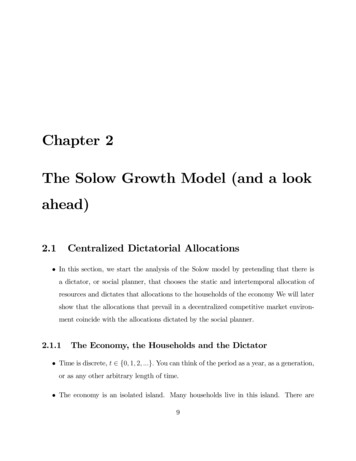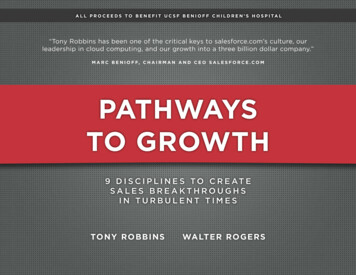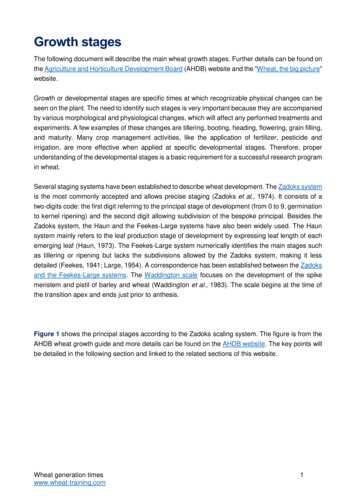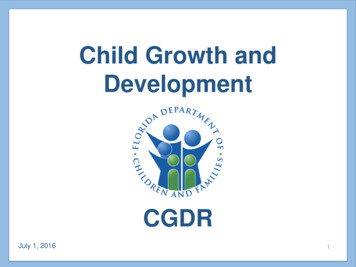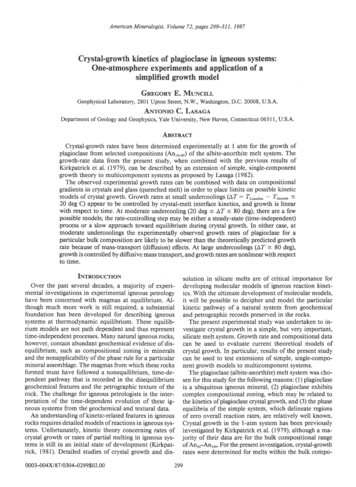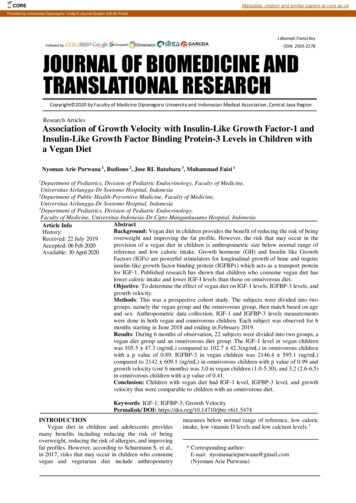
Transcription
COREMetadata, citation and similar papers at core.ac.ukProvided by Universitas Diponegoro: Undip E-Journal System (UEJS) PortalJ.Biomed.Transl.ResISSN: 2503-2178Copyright 2020 by Faculty of Medicine Diponegoro University and Indonesian Medical Association, Central Java RegionResearch ArticlesAssociation of Growth Velocity with Insulin-Like Growth Factor-1 andInsulin-Like Growth Factor Binding Protein-3 Levels in Children witha Vegan DietNyoman Arie Purwana 1, Budiono 2, Jose RL Batubara 3, Muhammad Faizi 11Department of Pediatrics, Division of Pediatric Endocrinology, Faculty of Medicine,Universitas Airlangga-Dr Soetomo Hospital, Indonesia2Department of Public Health-Preventive Medicine, Faculty of Medicine,Universitas Airlangga-Dr Soetomo Hospital, Indonesia3Department of Pediatrics, Division of Pediatric Endocrinology,Faculty of Medicine, Universitas Indonesia-Dr Cipto Mangunkusumo Hospital, IndonesiaAbstractArticle InfoBackground: Vegan diet in children provides the benefit of reducing the risk of beingHistory:overweight and improving the fat profile. However, the risk that may occur in theReceived: 22 July 2019provision of a vegan diet in children is anthropometric size below normal range ofAccepted: 06 Feb 2020reference and low caloric intake. Growth hormone (GH) and Insulin like GrowthAvailable: 30 April 2020Factors (IGFs) are powerful stimulators for longitudinal growth of bone and requireinsulin-like growth factor binding protein (IGFBPs) which acts as a transport proteinfor IGF-1. Published research has shown that children who consume vegan diet haslower caloric intake and lower IGF-I levels than those on omnivorous diet.Objective: To determine the effect of vegan diet on IGF-1 levels, IGFBP-3 levels, andgrowth velocity.Methods: This was a prospective cohort study. The subjects were divided into twogroups, namely the vegan group and the omnivorous group, then match based on ageand sex. Anthropometric data collection, IGF-1 and IGFBP-3 levels measurementswere done in both vegan and omnivorous children. Each subject was observed for 6months starting in June 2018 and ending in February 2019.Results: During 6 months of observation, 22 subjects were divided into two groups, avegan diet group and an omnivorous diet group. The IGF-1 level in vegan childrenwas 105.5 47.3 (ng/mL) compared to 102.7 42.3(ng/mL) in omnivorous childrenwith a p value of 0.89. IGFBP-3 in vegan children was 2146.4 595.1 (ng/mL)compared to 2142 609.1 (ng/mL) in omnivorous children with p value of 0.99 andgrowth velocity (cm/ 6 months) was 3.0 in vegan children (1.0-5.30), and 3.2 (2.6-6.5)in omnivorous children with a p value of 0.41.Conclusion: Children with vegan diet had IGF-1 level, IGFBP-3 level, and growthvelocity that were comparable to children with an omnivorous diet.Keywords: IGF-1; IGFBP-3; Growth VelocityPermalink/ DOI: NVegan diet in children and adolescents providesmany benefits including reducing the risk of beingoverweight, reducing the risk of allergies, and improvingfat profiles. However, according to Schurmann S. et al.,in 2017, risks that may occur in children who consumevegan and vegetarian diet include anthropometrymeasures below normal range of reference, low caloricintake, low vitamin D levels and low calcium levels. 1* Corresponding author:E-mail: nyomanariepurwana@gmail.com(Nyoman Arie Purwana)
7Journal of Biomedicine and Translational Research, 6 (1) 2020, 6-10In 1940, vegetarian population in England was 0.2%,which rose to 3 - 7% in the year 2000.2 The vegetarianpopulation in Shanghai in 2015 was around 0.77%, whilein Germany, 2.1 - 6.1%, the United States 1.9 - 4% andin India, 36%.1,3,4,5 The total population of vegetarians inIndonesia in 1998 was 5000 but in 2000 it increased to60000.6A recent study by Roman P et al. in 2017 showed thatchildren with a vegetarian diet had lower mean heightcompared to non-vegetarian children.Causes ofdisturbances in growth velocity in vegan children weredue to limited intake of essential proteins and aminoacids, low insulin-like growth factor-I (IGF-1) andinsulin-like growth factor binding protein (IGFBP-3)levels.10,11,12,13,14,15Height growth occurs in the growth plate cartilagewhich is regulated by the work of an endocrine complex.Growth hormone (GH), IGF-1 and IGFBPs are the mainendocrine complexes that play a role in growth. Growthhormone and IGFs are powerful stimulators forlongitudinal growth of bone.16,17 Insulin-like growthfactors require transporters to the target tissue. Insulinlike growth factor binding protein works as a transportprotein for IGF-1. Normal IGF-1 levels are needed forgrowth on the epiphyseal plate.18 This comparative studyaims to see the effect of vegan diets on IGF-1 levels,IGFBP-3 levels, and growth velocity of these children.MATERIAL AND METHODSThis study was a prospective cohort study conductedover six months. The study subjects were divided intotwo groups, namely those with a vegan diet and thosewith an omnivorous diet matched by age and sex.Anthropometric data collection, IGF-1 and IGFBP-3levels measurements were done in both vegan andomnivorous children in selected communities uponrecruitment. Subjects recruitment began in June 2018and ended in February 2019. Subjects were observedstarting from the first measurement and continued untilsix months.The study population was children with a vegan dietor omnivorous diet aged 3 to 9 years who were incommunities and schools in Denpasar, Surabaya andBalikpapan. Vegan children were selected frommembers of Supreme Master Ching Hai InternationalAssociations (SMCHIA) in Indonesia which required itsmembers to be vegan. Omnivorous children werematched according to age and sex.Universal sampling was done in this study. Theinclusion criteria were vegan children aged 3 to 9 yearsold who had been consuming a vegan diet for at least 6months. The exclusion criteria were children withgrowth disorders, children with malnutrition, childrenwho consumed food supplementation, children with tallstature, children with short stature, children with bonedeformities, children who were in the puberty phase(Tanner 2 or more) at the beginning of the study,children on growth hormone therapy, and children withsyndromes that cause growth disorders.The operational definition of vegan children waschildren with diet that excludes any animal productssuch as animal flesh (meat, poultry, fish and seafood)and animal products (eggs, dairy, honey) for 6 months ormore.5,7,11,19,20 Omnivorous or non-vegan children werechildren who had consumed all types of foods andbeverages made from animal and vegetable-basedingredients for more than once a week.21 Height was thelength of the body in a position of standing straight on theaxis of the body from head to toe. Height was measuredin cm. Height measurement was done barefoot. Heel,buttocks, shoulders, back and the back of the head mustbe in contact with the wall.22,23 Height was measuredonce using OneMed brand stadiometer height gauge inall subjects with a level of accuracy to one decimal. IGF1 levels were measured using the IMMULITE 2000 IGFI machine. IGFBP-3 levels will vary according to age, sexand puberty status.24,25 IGFBP-3 levels were measuredusing the Biorad ELISA Reader 680 machine.The study was approved by the Ethics Committee ofFaculty of Medicine, Universitas Airlangga-Dr. SoetomoHospital number 29/EC/KEPK/FKUA/2018. Writteninformed consent was obtained from the parents.Interviews were then conducted to complete the studyquestionnaireandsubsequently anthropometricmeasurements of height, IGF-1 and IGFBP-3examinations were performed in the first month uponrecruitment. After six months of observation repeatedheight measurements were done. Data were analyzed bySPSS for windows version 20.0.RESULTSThe sample of this study were 17 vegan children whomet the study criteria; 6 children were excluded as therewas no parental consent. Thus only 11 children werewilling to participate in the study until completion.The mean age of the study subjects in the vegan dietgroup was 74.1 20.7 months and in the omnivorous dietgroup, 72.2 16.9 months. The number and sex in bothgroups were similar.During 6 months of observation, the 22 subjects weredivided into two groups, a vegan diet group and anomnivorous diet group. There were no statisticaldifferences between the age of the children (in months)and sex in the two study groups (p 0.81; p 1,000). IGF1 values in children with a vegan diet and omnivorous dietwere not statistically different. IGFBP-3 in children witha vegan diet and omnivorous diet were not statisticallydifferent (Table 1). Growth velocity in both groups wasalso not statistically significant (p 0.05) as listed in Table1.Table 1. Comparison of IGF-1 level, IGFBP-3 level and growthvelocityVegan diet,OmivorousVariablen 11diet, n 11pIGF-1 (ng/mL)105.5 47.3102.7 42.30.89IGFBP-3 (ng/mL)2146.4 595.12142 609.1Growth Velocity(cm/6 months)3.0 (1.0-5.30)3.2 (2.6-6.5)The value of IGF-1 and IGFBP-3 was in mean SDGrowth velocity was in median, min-maxStatistically significant if p 0.050.990.41DISCUSSIONThe results of the study by Krupp D et al., in 2016,found that children aged 6 months to 19 years old withincreased consumption of vegetables and fruits showedno difference in IGF-1 and IGFBP-3 levels.27
Journal of Biomedicine and Translational Research, 6 (1) 2020, 6-10Randomized blinded clinical trial in vegan adults alsogave similar results.28 Vegan adults have the samecalorie, total protein, zinc, selenium, magnesium,calcium, phosphate and potassium as non-vegetarians(omnivores).29,30,31,32 Vegan children have consumptionof protein, calcium, zinc which are according to therecommended daily requirements (RDA).34Nutritional needs of children in Indonesia is based onthe Indonesian Minister of Health Regulation No. 75 of2013. Children's nutritional needs are adjusted for ageand sex. Ernawati F et al. in 2016 showed that childrenaged 37 to 59 months consumed as much animal proteinas 21.9 g / day and vegetable protein of 17.8 g / day oraccording to 139.8% from the mean adequacy ratio(MAR). The largest source of animal protein was fromfish, milk (along with its processed products), eggs andmeat or chicken. The most abundant source of vegetableprotein comes from cereals, nuts and seeds. 35 Childrenaged 4 to 6 years in India has an average proteinconsumption of 47.3 g / day with a composition of 10 to20% animal protein and 80 to 90% vegetable protein.The highest source of vegetable protein comes fromcereals and grains while the largest source of animalprotein comes from milk and its processed products. 1,4,36Adequacy of nutrition for children with a vegan diet aresimilar to children with an omnivorous diet. Differencesexist in fiber and protein intake which are slightly higherthan the recommended dietary allowance (RDA)because of differences in protein absorption and aminoacid composition.37,38,39The number of calories and calcium consumed isrelated to the level of IGBBP-3.30,31 In adults with avegan diet, they have the same consumption of caloriesand calcium as in adults with omnivorous diet. 12,31Vegetarian children have the same total calorie andcalcium consumption as omnivorous children. 11However, Hebbelinck M et al., in 1999 showedcontradictary results. Prepubertal vegetarian children inthe Flemish group received lower caloric intakecompared to the references. Male vegetarian childrenconsumed 6372 1297 of calories (mean SD), whilethe female children consumed 5749 13393 (mean SD).40A study by Haugen MA et al., in 1993 also showedthat adults on a vegan diet for 3.5 months had reducedIGF-1 levels compared to adults on a normal(omnivorous) diet; this difference was however notstatistically significant. On the other hand, Allen NE etal., in 2000, showed a significant reduction in IGF-1level.41,42In a study by O Connell JM et al., in 1988 inTennessee, United States which included a group ofvegetarian children aged 2 to 10 years, the growth rateof vegetarian and non-vegetarian children was similaraccording to the reference curve especially at the age ofmore than 5 years, while at the age of less than 5 years,the rate of height growth was lower in the vegetariangroup and this was statistically significant. 43 Anotherstudy by Nathan I, in 1997 showed that growth velocityin vegetarian children aged 7 to 11 years ranged from6.48 cm / year and 6.05 cm / year in omnivorous childrenbut there was no statistical difference. 22 Our resultshowed that the vegan diet group has a lower growthvelocity but was not statistically significant.8CONCLUSIONChildren with vegan diet had comparable though notsimilar IGF-1 and IGFBP-3 levels as children withomnivorous diet. Children with vegan diet had similargrowth velocity as children with omnivorous diet.Further study is needed to determine the structure andmechanism of IGF-1 formed from amino acids fromvegetable protein sources.ACKNOWLEDGMENTSOur appreciation to Nur Rochmah from Departmentof Pediatrics, Division of Pediatric Endocrinology,Faculty of Medicine, Universitas Airlangga-Dr SoetomoHospital, Indonesia who had given suggestions regardingthe study.REFERENCES1. Schürmann S, Kersting M, Alexy U. VegetarianDiets in Children: a Systematic Review. Eur J Nutr.2017;56(5):1797–17.2. Phillips F. Vegetarian Nutrition Update. London:British Nutrition Foundation Bulletin. 2005;30:13267.3. Mao X, Shen X, Tang W, Zhao Y, Wu F, Zhu Z, etal,. Prevalence of Vegetarians and Vegetarian’sHealth Dietary Behavior Survey in Shanghai. WeiSheng Yan Jiu. 2015;44(2):237–41.4. Cramer H, Kessler CS, Sundberg T, Leach MJ,Schumann D, Adams J. Characteristics of AmericansChoosing Vegetarian and Vegan Diets for HealthReasons. J Nur Educ Behav. 2017;49(7):561–7.5. Amit M, Canadian Paediatric Society, CommunityPaediatrics Committee. Vegetarian Diets in (5):303–8.6. Siahaan G, Nainggolan E,
velocity Variable Vegan diet, n 11 Omivorous diet, n 11 p IGF-1 (ng/mL) 105.5 47.3 102.7 42.3 0.89 IGFBP-3 (ng/mL) 2146.4 595.1 2142 609.1 0.99 Growth
